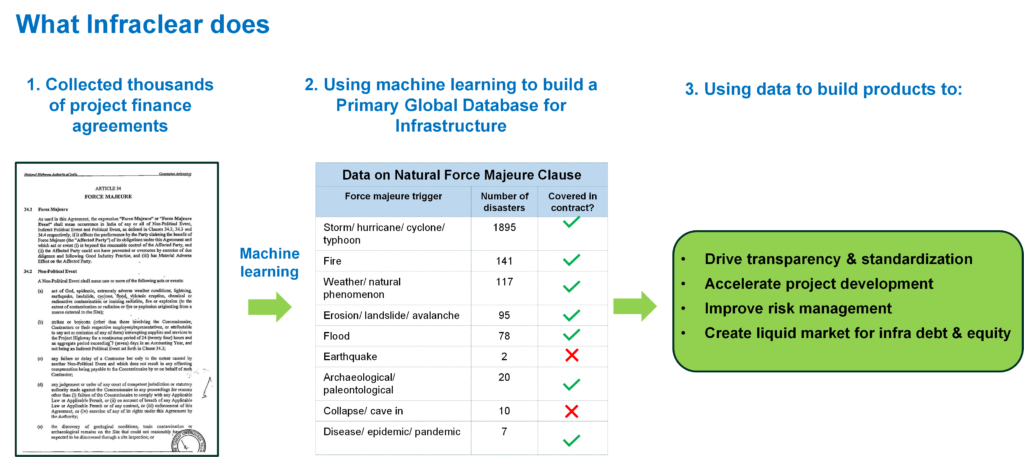
For years, infrastructure has struggled with the lack of transparency, lack of bankable projects, poor risk management, and lack of liquidity. The use of big data and machine learning can help us make a breakthrough.
Project development and project finance are challenging businesses.
While many investors are keen to invest in well-developed, sustainable infrastructure projects, not enough bankable projects are coming to market. It can take years to develop and finance a project. Typically, the soft costs of developing a project can be 8-12% of project costs[1].
If one considers the project finance market, where about $500 billion of debt and equity is invested every year, around $50 billion is being spent on project development. If one takes a larger view and considers the approximately $4 trillion spent annually developing public and private infrastructure, the amounts spent on project development are staggering, amounting to perhaps $400 billion per year.
Much of this is wasted. Despite spending all this time and money, over 90% of viable projects to which sponsors start committing capital, never get built.[2] Around 45% of projects that do get built, get renegotiated/ restructured. This is a terrible track record.
Given the amount of sustainable, climate-friendly infrastructure that must be developed to save our planet, we cannot afford to keep repeating the mistakes of the past.
So what can we do? Project finance professionals agonize about the lack of standardization, lack of government capacity, incomplete regulation, changing political will, etc. But two problems—the lack of digitization and the lack of data—haven’t gotten as much attention. They may hold the keys to a breakthrough.
Lack of digitization.
Little about project finance or the process of developing projects has changed over the last several decades. Pick up a concession agreement from the 1960s and compare it to one today, and they look remarkably similar. Agreements are still drafted by hand, with face-to-face negotiations.
While the automobile industry is using AI to develop self-driving cars, and vaccine developers have used big data to dramatically shorten vaccine development lead times, it is probably fair to say that the last technology tool that was adopted by project finance professionals is a Microsoft Excel spreadsheet—a software tool first created in 1985. Construction is the least digitized sector in the world after agriculture[3].
There is a lot of ground the industry needs to make up. However, getting there may be easier than we think.
In 2020, the Asian Infrastructure Investment Bank released a Digital Infrastructure Sector Analysis[4], which highlighted the opportunities to use technology to transform infrastructure. They noted that there are two kinds of digital infrastructure:
– Hard digital infrastructure (physical assets, e.g., data centers, drones, undersea cables)
– Soft digital infrastructure (big data, AI, and cloud computing, applied to existing infrastructure)
AIIB also noted that over the past few years, machine learning, natural language processing and big data analytical techniques have become not only more sophisticated, but also easier for lay users to use. So, if the tools are available, how should we use them?
Lack of data:
Data is the foundation for all digital transformation. Decision makers need data on how prior projects have been structured, their terms and risks, and performance. They are also seeking data on climate risks, ESG risks, regulatory risks, and on factors that could affect the project.
The G20 recognized that robust and accessible data are needed for both private and public investors to make better-informed decisions about capital allocations to sustainable and quality infrastructure. The G20 Principles for Quality Infrastructure Investment (2018) emphasize that access to adequate information and data is an enabling factor to support investment decision-making, project management and evaluation.
To this end, G20 Infrastructure Working Group launched an Infrastructure Data Initiative (IDI) in 2017. It promoted discussion and coordination of initiatives led by the likes of EDHECinfra, EIB’s Global Emerging Markets Risk database, GRESB, Moody’s, SOURCE, the Global Infrastructure Hub, OECD, multilateral development banks, and international organizations, along with the private sector (Incl. LTIIA). But it has yet to come up with an operational roadmap.
How to use AI and big data—effectively.
Infraclear is a fintech/ software-as-a-service company founded by people with expertise in infrastructure finance, natural language processing, machine learning, and cloud computing. In the recent Infrachallenge competition (organized by the G20’s Global Infrastructure Hub and supported by the Italian G20 Presidency), Infraclear was named to the final list of top 20 “infra tech” innovations.
Infraclear has assembled one of the world’s largest repositories of infrastructure project agreements (several thousand and counting). It is using natural language processing and machine learning to extract data from these documents and build a primary database of project terms and risks. Such granular data has never been available at scale.
How could investors and governments use this data?
Using this data, Infraclear is building tools to address specific pain points faced by banks, developers, insurers, governments, and institutional investors.
- Simplify project development.
Without data on “what terms have yielded better performance in the past” project development may devolve into a series of endless bickering and negotiations. Parties negotiate for months about what governing law to use, or what the liability caps should be for a construction contract. As negotiations drag on, legal expenses mount, and teams get frustrated. At some point, developers burn out of capital, governments lose patience, and the parties walk away. What was a viable project, never ends up getting built.
Instead, imagine a scenario where an analyst could instantly pull up the liability caps for 500 recent projects, and point out at what levels loan defaults were minimized. Parties would no longer have to negotiate in a vacuum. They could use data to rapidly assess (i) what is market and (ii) what works well.
The availability of such data for all key terms of a project financing could make a dramatic impact. Instead of spending months trying to find information, information would be ready and available, at one’s fingertips. Extensive discussions with project finance bankers suggest that such tools could reduce the time it takes to develop projects 30%, reduce total project costs 3-6%, and increase banks’ project finance lenders’ margins by up to 10%.
- Easily analyze risks in a portfolio.
It can take a bank or institutional investor weeks to read through project agreements and understand what climate and other risks are not covered. The tools Infraclear is developing will allow them to analyze risks in a matter of hours. With such information, a lender or government could work with an insurer to protect their portfolio from climate risks.
- Create a secondary market for infrastructure loans.
Nearly $3 trillion of infrastructure loans are outstanding, and less than 1% of infrastructure loans have been securitized. Bayfront Infrastructure was set up by the Singaporean government and several multilaterals and financial institutions to help securitize infrastructure loans. The FAST Infra consortium (Finance to Accelerate the Sustainable Transition- Infrastructure)[1], has also been exploring creating a securitization marketplace.
Since infrastructure is an opaque and illiquid asset class, regulators force institutional investors to hold a lot of capital in reserve. This makes securitization costly. Granular data on project risks and performance will be able to bring transparency and comparability across projects and portfolios. Analysis conducted by the World Bank[2] suggests that this could dramatically reduce capital charges associated with securitizing infrastructure loans. It could boost the return for a securitized infrastructure loan portfolio by 1.0 to 2.5 percentage points.
Digital transformation is coming to infrastructure. It will be a game-changer. Infrastructure is an unnecessarily complex asset class. Data and digitization can simplify its investment processes and bring transparency. The opportunity is here: it is up to us to seize it.
Giridhar Srinivasan is a co-founder and the CEO of Infraclear Inc., a fintech company focused on the infrastructure sector. Prior to starting Infraclear, he spent 15 years working on infrastructure investments at the International Finance Corporation (IFC), Rothschild, and Lehman Brothers.
Francois Bergere is the Executive Director of the Long Term Infrastructure Investors Association.
[1]When including the costs spent by developers, sponsors, and lenders
[2] Contributions to Global Infrastructure Facility, Ministry of Foreign Affairs, Denmark, 2019, pp 22-23
[3] Imagining Construction’s Digital Future, McKinsey & Co. 2016
[4] Digital Infrastructure Strategy & Analysis
[5] FAST Infra https://www.climatepolicyinitiative.org/fast-infra/
[6] Jobst, Andreas A. 2018. Credit Risk Dynamics of Infrastructure Investment : Considerations for Financial Regulators. World Bank, Washington, DC. https://openknowledge.worldbank.org/handle/10986/29540
